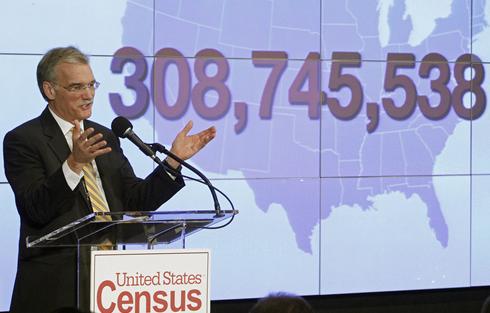

04/23/2012
Mass immigration enthusiasts sometimes assert that importing lots of foreigners helps to lower Americas average age which puts a larger percentage in the workforce. But like many immigration claims, that one has never been true. CIS reported in 2007 that Recent immigration has had no significant impact on the nation’s age structure.
Plus, just being young isnt that great if the cohort lacks job skills, and the family reunification strategy of Ted Kennedy and other Democrats has created a hopeless immigrant underclass in an economy that increasingly needs skilled workers.
In any case, the accumulation of decades of extreme levels of immigration has been noticed by the Census. Now those young unskilled immigrants and illegal aliens from the early wave after 1965 have become old. What a surprise. And the aging immigrants need more expensive social services, particularly medical.
Below, the Census announced the official results of its 2010 enumeration.

In addition, younger immigrants bring aging parents, who can get welfare benefits in a few years with citizenship without ever paying a penny into the system. H-1b expert Prof. Norm Matloff reported in 1996 that approximately 55% of elderly Chinese immigrants were on welfare and its doubtful the number has decreased since then.
Naturally California is leading the way with immigration bad news, although no dollar estimates are provided in the following article, presumably because nobody wants to know how much all this diversity will cost the taxpayers in the near future and going forward.
Census: Older Asian, Hispanic populations growing, Associated Press, April 19, 2012
The number of older Asians and Hispanics in California is rising more than three times faster than that of whites, creating a need for more health and social services for these populations, according to census data and interviews.
Overall Asians and Hispanics are the fastest growing groups in the state, but the rise in adults 55 years and older in those groups is particularly pronounced, the Associated Press found by analyzing census data released Thursday.
Experts say the increase in older Asian and Hispanic adults is partly due to the aging of immigrants who came to the U.S. for jobs or to seek refuge from war. Another reason is that some established immigrants are bringing parents from their native country. Also, some Asians and Hispanics have especially long life expectancies.
Whites remain the largest group of older people. But growth in the 55-plus population between 2000 and 2010 for Asians was 74 percent and for Hispanics 73 percent. That compares with only an 18 percent growth rate for whites and 34 percent for blacks.
Advocates and providers say these rapidly growing older populations, comprised of large numbers of immigrants, are increasing the need for culturally-specific services and putting a strain on already thin financial resources.
The White Anglo population that was born and raised here had good jobs with Social Security and pensions and was able to acquire assets. A lot of our immigrant seniors did not have the opportunity to develop a good financial base to be able to support themselves when they grow old, said Gloria Bonilla, executive director of Centro Latino de San Francisco, which serves seniors in the Bay Area.
Hispanics and Asians tend to be more isolated and lack access to health care and other services because of their language skills and cultural differences, according to government officials.
Americans are getting older in general. But if we look at the elderly immigrant population among Latinos and Asians, the challenges are greater, said David Ishida, the regional administrator for the U.S. Administration on Aging.
Some are unfamiliar with services offered, Ishida said. Others are being taken advantage of because they dont speak English. Still others are too poor to afford care.
Some of the largest increases in the above-55 set were seen among the Japanese, Chinese, Vietnamese and Asian Indians, the data shows.
The reasons are varied, said Nancy Gemignani, a demographer at the California State Census Data Center:
The Vietnamese, who arrived after the Vietnam war, are just now becoming older. The elderly from India are being brought to this country by children working in the high-tech industry. Hispanics, who worked as farmworkers after World War II and others who migrated to California in the 70s and 80s, are also now aging. And the Japanese-Americans and Chinese have high life expectancies.
While more providers are now able to meet the demand of diverse seniors than a decade ago, appropriate services are still sparse for this growing elderly population, said Amy Phillips, director of senior services at Little Tokyo Service Center in Los Angeles.
Many Asian elderly immigrants heavily rely on in-home services or on care provided by their children, Phillips said. Those communities place a high value on family and hold a stigma against putting elderly people in nursing homes, she said. And those families often cant afford the cost of nursing homes and other care.
For some Latino elderly, an additional burden is the lack of legal immigration status, said Bonilla. Those seniors cannot access government programs such as SSI, Medicaid or get any government cash assistance.
That means seniors who are here illegally may receive little or no health care until their problems are compounded and they require costly hospitalizations, Bonilla said.
The implications of the fast growth among the Asian and Latino older people are profound, said Ladson Hinton, director of geriatric psychiatry at the UC Davis medical center.
The health care system, he said, needs to be more responsive to the cultural and language differences of this growing group of patients.
Those services for Asian and Hispanic people are especially crucial, Hinton said, as more of them are now at risk for diseases such as Altzheimers and dementia that strain the health care and social service systems.
If the state doesnt do a good job treating these older adults, Hinton said, it has a spillover effect. We need appropriate treatment and support for them.